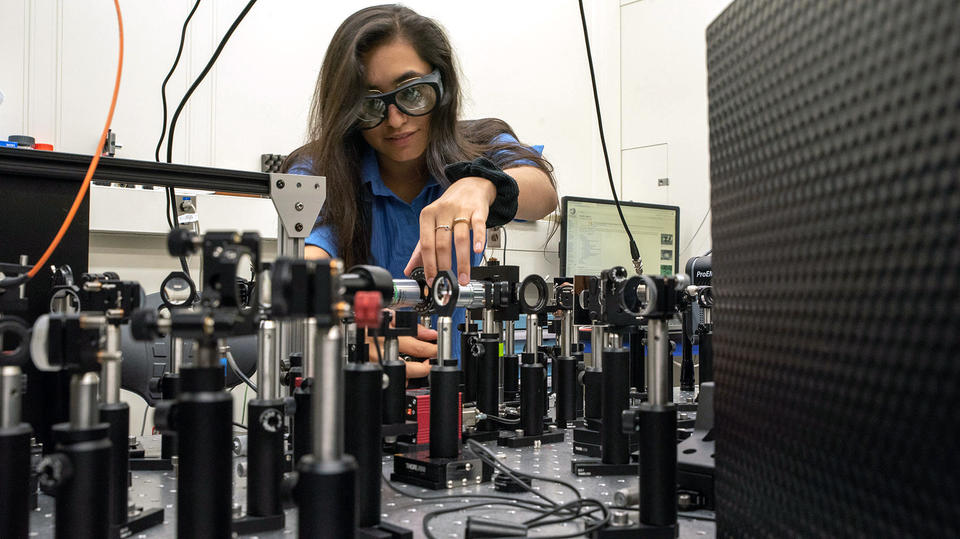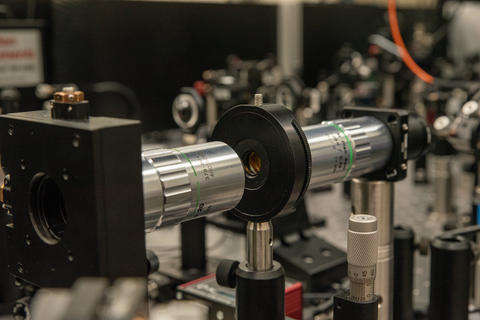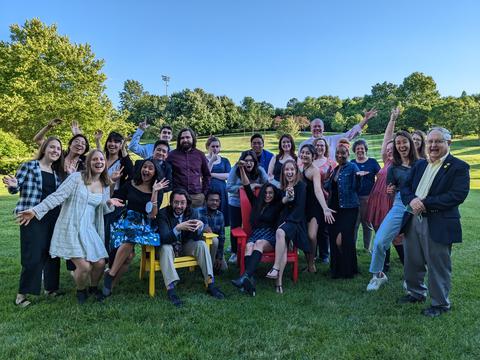Taking Measure
Just a Standard Blog

During her NIST internship, Valeria Viteri-Pflucker helped to develop and test a new experimental technique to measure nonlinear optical properties in materials.
At the age of 13, I had firmly decided that I wanted to be a particle physicist, whatever that meant. All I knew is that I wanted to play with subatomic particles and was particularly fascinated by the idea of antimatter. Whenever I’d tell my parents or friends this goal, they’d inevitably ask what a particle physicist does, since they’d never met one. Amusingly enough, I didn’t really know either, but that didn’t matter.
Fast-forward to where I am now. I earned a bachelor’s degree in physics from Illinois Wesleyan University in May, and this month, I am beginning my graduate journey with a Ph.D. program in optics at the University of Rochester. During the summer, I was one of 16 students participating in a Society of Physics Students (SPS) internship program in the Washington, D.C., area, and I am one of three stationed at NIST. For many years now I have been trying to answer the question of what a physicist does. This summer has fundamentally shaped my answer to this question.
My primary sources of information have been (1) doing physics and (2) meeting physicists. This summer has had a lot of both, but I will start with the former. During my interview process I was very clear about what I wanted for this internship. Half of my undergraduate career had been during the COVID-19 pandemic, so I wanted hands-on experimental experience outside of a classroom environment before going to graduate school. I had already decided to pursue a career in optical physics, but so far much of my research had been performed on computers due to the pandemic. In response to my plea to be placed in an optics lab, I was assigned to work with Jared Wahlstrand in NIST’s Nanoscale Spectroscopy Group.
Doing Physics
For my internship project, Jared asked me to help develop and test a new experimental technique to measure nonlinear optical properties in materials. By optical properties, I am talking about how the material slows down and absorbs light of different colors. By nonlinear optical properties, I mean how this slowing and absorbing depends on the intensity of the light. The experiment I’ve helped develop and test uses a form of holography, a technique that records light waves and later reconstructs them, to measure small changes in a light pulse’s properties. It should yield higher precision than other current methods, extract information on a wide range of colors in a single measurement, and work on very small pieces of material.
When I think of optics I usually envision lasers, mirrors and lenses scattered atop an optical table (as the pictures show, it’s a table holding lots of optical equipment while minimizing vibrations that would disturb the experiment). Nowadays, researchers are interested in placing all those optical components onto a tiny chip, an approach known as integrated optics.

The ultimate goal is to create miniature optical circuits like the miniature electrical circuits that revolutionized electronics by making possible laptop computers and pocket smartphones. Using photons instead of electrons as a medium of communication opens doors for even faster processing, greater bandwidth and lower amounts of signal loss.
Optical circuits contain important components known as wave guides through which light travels. Engineers want to select the best-performing material to use as the wave guides. A material’s nonlinear optical properties can enhance the functionality of the circuit but can also be detrimental to its operation. To choose the best material for the job and to model these systems well, these nonlinear properties need to be well measured. During the summer, we were working on making those precise measurements.
As a first material, Jared asked me to measure the optical properties of gallium phosphide, an orange/gray semiconductor that shows promise in integrated optics. Its nonlinear absorption properties have not been measured at many wavelengths of light.
Our measurement is based on what is called a pump-probe spectral interferometry experiment. In a pump-probe experiment, a short laser pulse excites a material and we “probe” it with a white light pulse (which is actually a lot of colors of light together) to see what the energized material did with the different colors of light. This technique allows us to measure how much of each color of light was absorbed and how much each color is delayed by the excited material.
After a lot of work, the experiment was up and running! In gallium phosphide we observed nonlinear absorption at the wavelengths we expected, and the technique is sensitive enough to measure very small effects. We also saw nonlinear refraction, in which light pulses experienced an extra delay due to the actions of the pump pulse. The amount of delay depends on the pulse’s color in a way that doesn’t seem to match a simple theory, suggesting a newly observed optical effect or an unforeseen problem with the measurement scheme.
Building confidence in the technique will require doing measurements on other materials whose nonlinear properties are well known. Overall, the initial results are promising. If the technique proves itself, it will be used on other materials, particularly ones where large samples are hard to make.
During this summer, I’ve needed a lot of help understanding how to use various laboratory equipment and how such equipment works on the inside, so I’ve received one-on-one mentoring in the lab helping me develop experimental skills. That was what I really wanted for my summer, and I have had a great time in that regard. I also got to learn about what some physicists do. I knew physicists had to be fantastic problem-solvers, but I hadn’t truly witnessed that in action. In the process of setting up and testing the technique we developed, there were many obstacles. The breadth of problems experienced was rivaled only by the breadth of solutions tried, and something went wrong every day — sometimes every hour.
It wasn’t only optics and physics equipment. Virtually everything in the lab interfaces with a computer in some way. Jared had written code to have computers control other computers, which in turn controlled a lot of our lab equipment. Everyone in the lab must be a little bit engineer, a little bit computer scientist.
Meeting Physicists

With regard to the second source of information, I learned a lot about physics outside of the classroom in a very big way! Most important was the SPS intern cohort itself. Of all the internship programs I’ve participated in, applied to, or read about, this one is unique. The diversity of physics shines through. Each intern is doing something completely different from everyone else, and each works at a different place. Despite that, we all live in the same dorm and share our experiences. I want to share what all the physics and astronomy majors have been doing this summer:
- Working on Capitol Hill (for Rep. Bill Foster, a physics Ph.D.)
- Writing about science policy for the American Institute of Physics (AIP)
- Working on public engagement for the American Physical Society (APS)
- Analyzing education and diversity statistics in physics for APS
- Understanding the impact of low-income education on career outcomes for the American Association of Physics Teachers (AAPT)
- Doing science writing for Physics Today
- Performing research on little-known women in physics history with the Center for History of Physics and the Niels Bohr Library & Archives
- Using food (such as coconut pudding or oobleck, which is cornstarch and water) to demonstrate non-Newtonian fluids (Society of Rheology)
- Creating Science Outreach Catalyst Kits (SOCKs) for undergraduate chapters of the Society of Physics Students
- Prototyping and integrating a star camera system (orients spacecraft by imaging star systems) for a cryogenic balloon telescope mission (NASA)
- Studying galaxy formation at the Space Telescope Science Institute
- Solving systems described by differential equations with machine learning at Potomac Research
- Working in the NIST Nanoscale Device Characterization Division
From the above you can see that the interns worked in areas such as science writing, the history of physics, astronomy, education, outreach, science policy and statistics. What I witnessed from this group is that doing physics can mean more things than doing research. I’ve been very happy with the work I’ve been doing in the lab, but I’m also glad I had the experience of thinking about the education side of physics or the science communication side of physics. It seems physicists wear many hats.
What Doesn’t a Physicist Do?
I think the confusion expressed by my friends and family, and especially myself, about what physicists do is much more justified than I would have expected. Research scientists work on a wide array of incredibly specific problems throughout the course of their careers, and all of them have developed their own unique toolboxes to field the problems they have.
In addition, there aren’t that many physicists. Each year in the U.S. around 9,000 people earn an undergraduate degree in physics. From there roughly half go to graduate school, and half go to the workforce. A lot of graduates go to the private sector for engineering or computer software. Not surprisingly, we do a lot of different things.
Something I'm very happy about is that this internship has reaffirmed that I really enjoy the research process. I’ve been curious about nonlinear optics for a long time, and this was the first time I got to interact with it directly. I’m excited for the next chapter in my life after NIST and am grateful for the experiences it has afforded me.
About the author
Related Posts
Comments
Valeria: Thank you for sharing your experience. I now have a greater appreciation for what a Physicist does and how they do it. You are well on your way to being a positive influence on our world.
Very proud of my daughter and what she has accomplished so far. Being self motivated and such a passionate intreast for her education sets her above any expectations could have dreamed of. Excited to see where the future takes her. Or rather where she takes our future.
Right?! She will continue to do amazing things!
Valeria—this is so cool! Thank you for sharing your experiences. I’m also a 2022 physics bachelors graduate (I entered the workforce right away), and it’s awesome to hear what my peers are up to.
I remember meeting Valeria when she was 13 years old and she was sitting in Farm and Fleet in Freeport Illinois waiting for her mother to get through the checkout line and reading a book on physics that I had also just recently read. I started a conversation with her and realized immediately that she understood what she was reading way better than I did and she actually helped clarify some things for me. Everyone who knew her at that time realized how incredible she was and what an amazing physicist she was going to grow up to be and we could not be more proud of her. I loved your article, Thank you for sharing that whole process with us
Wow! This is cool! I so proud of you and as part of your child life, I knew you will be maybe a writer, reporting etc, but you are far of my imagination! Congratulations 👏
glad for you






Thank you Valeria for your article. I think you could also be a science writer btw. I graduated from UCLA with a masters in physics in 1980. I ended up in Silicon Valley working on equipment to make chips. I was an applications engineer for a few years and then went to the business side. I became a CEO for 2 public companies and now I am a board member for several companies. Physicists do a lot of different things. Enjoy the career!